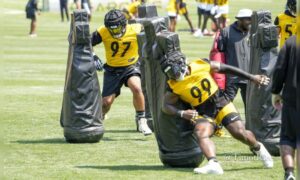The Pittsburgh Steelers’ 2020 season ended, needless to say, in a way that nobody around here particularly wanted. After winning their first 11 games of the season, they finished the regular season on a 1-4 slide, and then were bounced out of the postseason 48-37 by the Cleveland Browns, who hadn’t won a playoffs game in 25-plus years.
While the five turnovers by the offense obviously played a dramatic role in the loss—Maurkice Pouncey’s botched snap on the first play of the game immediately produced seven free points for Cleveland—the defense’s inability to contain the Browns’ offense is very much on the hook as part of the blame for the dismal result.
So how did it come to this, for a team that ranked third in the entire NFL in defensive scoring prior to this? It was the first game in which they had allowed such a score in years, and that doesn’t happen without the defense playing a big part in the sucking.
“If I could culminate it, I would just say that we didn’t do what we’re good at”, defensive lineman Cameron Heyward summarized while speaking on WDVE radio yesterday. “We’re a team built for stopping the run, getting turnovers, playing with a lead. There were a lot of things that went wrong in that game. Our execution was not up to par. It’s playoff football. I attest that to us not being ready. That’s all I can say right now. It’s playoff football. The execution has to be at a higher rate, and it wasn’t”.
You never want to hear anybody on your team say that they feel they weren’t ready for a game. Job one in the NFL is being ready. There is never an excuse for a professional athlete not being ready, or for their coaches to not have them ready.
But it is immediately where the mind goes, even for those on the field, when you put up a result that bad. How could this have happened? You ask yourself. Well, we must not have been ready. We weren’t prepared for what we faced.
They certainly weren’t prepared to navigate a minus-five turnover margin, or to overcome a 28-0 deficit by the end of the first quarter, the largest point differential after the end of the first quarter of a game in the history of the NFL.
The fact is that they allowed another 20 points over the course of the final three quarters as well, so that’s not good, either. The offense played well in spurts and ultimately got into the end zone several times, but it was too little, too late.








